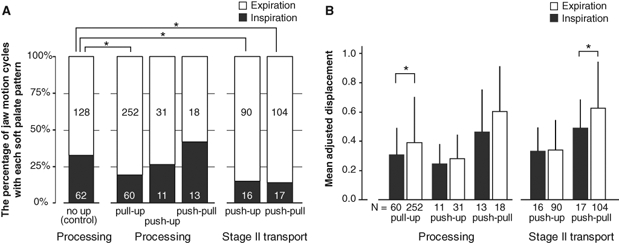Figure 4.

Interaction of respiration and soft palate motion in (A) the frequency and (B) displacement of soft palate movement. (A) Stacked columns showing the percentage and number of processing and stage II transport cycles of the jaw that occurred during inspiration (gray) and expiration (white). The counts of jaw cycles with no soft palate movement (the no-up pattern) served as the statistical control for cycles with soft palate movement. During processing, jaw cycles with pull-up were significantly less frequent during inspiration (p < 0.001, logistic regression analysis). During stage II transport, cycles with push-up and push-pull were significantly less frequent during inspiration (p < 0.004). Swallow cycles are not shown, since there was no air movement during the swallow. (B) Bar graphs showing the mean (± SD) adjusted amplitude of soft palate displacement for each soft palate movement pattern and each jaw cycle type. The amplitude of pull-up soft palate displacement was significantly smaller during inspiration (dark bar) than during expiration (white bar) in processing cycles (p = 0.04, mixed-model ANOVA). During stage II transport cycles, the amplitude of push-pull displacement was significantly smaller during inspiration than during expiration (p = 0.03). Swallow cycles are not shown, since there was no air movement during the swallow. *P < 0.05 for comparison with control cycles. *P < 0.05 for inspiration vs. expiration.
